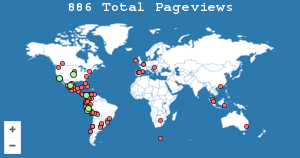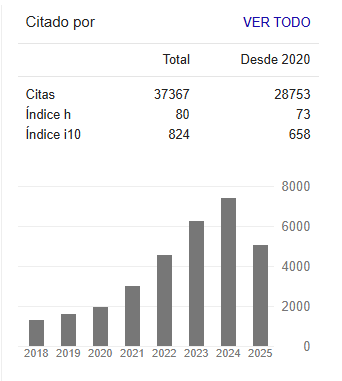Determinants of attitude towards and purchase intention of private label brands in Ecuador
Resumen
The purpose of this study is to explain which factors influence the attitude towards private label products and their purchase intention in Ecuador. In this regard, the hypothetical effects of store image, familiarity with the private brand, its perceived quality and risk, and customers’ price consciousness, are studied. A survey distributed online was implemented, obtaining a final sample of 224 customers of the main supermarket chain in Ecuador: Supermaxi. A Confirmatory Factor Analysis was performed, and a structural equations model was tested by consistent Partial Least Squares. Among the most relevant findings, it was found that attitudes towards private brands are a critical determinant of purchase intention; that a better image of the supermarket reduces the perceived risk, fostering consumer’s purchase intention. Familiarity with the private brand positively affects perceived quality, which, along with price consciousness, contributes to building attitudes towards private brands. Taken together, these results suggest that supermarkets should work on the tangible and intangible aspects that create store image to contribute to private brands sales. We also recommend marketing tactics such as product samples and testimonials to build brand familiarity among consumers, which along with meeting quality expectations will improve attitudes toward and purchase intention of private label brands. Finally, supermarkets need to be aware of those product categories in which consumers are most price-conscious in order to highlight the savings derived from private label products and promote more sales.
Citas
Beneke, J., Flynn, R., Greig, T., & Mukaiwa, M. (2013). The influence of perceived product quality, relative price and risk on customer value and willingness to buy: a study of private label merchandise. Journal of Product & Brand Management, 22(3), 218-228. https://doi.org/10.1108/JPBM-02-2013-0262
Beneke, J., Greene, A., Lok, I., & Mallett, K. (2012). The influence of perceived risk on purchase intent the case of premium grocery private label brands in South Africa. Journal of Product & Brand Management, 21(1), 4-14. https://doi.org/10.1108/10610421211203060
Buil, I., Martínez, E. & de Chernatony, L. (2013). The influence of brand equity on consumer responses. Journal of Consumer Marketing, 30(1), 62 – 74. https://doi.org/10.1108/07363761311290849
Calvo-Porral, C., & Lang, M. (2015). Private Labels: The role of Manufacturer Identification, Brand Loyalty and Image on Purchase Intention. British Food Journal, 117(2), 506-522. https://doi.org/10.1108/BFJ-06-2014-0216
Cian, L., Krishna, A., & Schwarz, N. (2015). Positioning Rationality and Emotion: Rationality Is Up and Emotion Is Down. Journal of Consumer Research, 42(4), 632-651.
El Comercio. (2012, September 7). Empresas apuestan a la marca propia. El Comercio. https://www.elcomercio.com/actualidad/negocios/empresas-apuestan-a-marca-propia.html
El Telégrafo. (2012, July 28). El Telégrafo. https://www.eltelegrafo.com.ec/noticias/economia/4/las-marcas-blancas-promueven-el-ahorro-en-los-consumidores
El Telégrafo. (2021, March 22). El Telégrafo. https://www.eltelegrafo.com.ec/noticias/economia/4/industria-nacional-en-marcas-propias
Forbes (2021). Las 20 empresas que más vendieron en el año de la pesadilla. https://www.forbes.com.ec/money/las-20-empresas-mas-vendieron-ano-pesadilla-n6568
Gefen, D., Rigdon, E., & Straub, D. (2011). Editor’s Comments: An Update and Extension to SEM Guidelines for Administrative and Social Science Research. MIS Quarterly, ٣٥(٢), III-XIV. https://doi.org/10.2307/23044042
Graciola, A. P., Toni, D. D., Milan, G. S., & Eberle, L. (2019). Mediated-moderated effects: High and low store image, brand awareness, perceived value from mini and supermarkets retail stores. Journal of Retailing and Consumer Services, 55. https://doi.org/10.1016/j.jretconser.2020.102117
Hair, J. F., Hult, G. T., Ringle, C. M., & Sarstedt, M. (2017). A Primer on Partial Least Squares Structural Equation Modeling (SEM) (2nd ed.). Los Angeles: SAGE Publications.
Hernández, L., Portillo, R., Romero, J., & Hernández, A. (2015). Diseños organizacionales y profesionalización empresarial en hipermercados y supermercados familiares en Venezuela. Revista De Ciencias Sociales, 20(2). https://doi.org/10.31876/rcs.v20i2.25669
Jaafar, S., Lalp, P., & Naba, M. (2012). Consumers’ perceptions, attitudes and purchase intention towards private label food products in Malaysia. Asian Journal of Business Management Science, 2(8), 73-90.
Keller, K. L. (1993). Conceptualizing, Measuring, and Managing Customer-Based Brand Equity. Journal of Marketing, 57(1), 1–22. https://doi.org/10.1177/002224299305700101
Konuk, F. A. (2018). The role of store image, perceived quality, trust and perceived value in predicting consumers’ purchase intentions towards organic private label food. Journal of Retailing and Consumer Services, 43, 304–310. https://doi.org/10.1016/j.jretconser.2018.04.011
Levy, M., & Weitz, B. (2019). Retailing Management. (10th ed.). New York: McGraw Hill
Lichtenstein, D. R., Bloch, P. H., & Black, W. C. (1988). Correlates of Price Acceptability. Journal of Consumer Research, 15(2), 243. https://doi.org/10.1086/209161
Macias, W., & Cerviño, J. (2018). Unauthorized Use of Famous Brands and Its Impact on Brand Equity Dimensions. Review of Marketing Science, 16(1), 1-24.
Manikandan, M. K. (2020). Store brand and perceived risk on private label brand attitude. Journal of Indian Business Research. https://doi.org/10.1108/JIBR-09-2019-0280
Mariño, D. (agosto de 2016). Superintendencia de Industria y Comercio. https://www.sic.gov.co/ruta-pi/agosto16/que-son-las-marcas-blancas
Meleán, R. (2017). Reinventar el negocio: Para vender más barato (o más caro) Autor: Josep-Francesc Valls Giménez. Negotium, 13(38), 94-97.
Merrilees, B., & Miller, D. (2010). Brand morphing across Wal-Mart customer segments. Journal of Business Research, 63(11), 1129–1134. https://doi.org/10.1016/j.jbusres.2009.10.008
Mieres, C., Martin, A., & Gutiérrez, J. (2006). Antecedents of the difference in perceived risk between store brands and national brands. European Journal of Marketing, 40(1/2), 61-82. https://doi.org/10.1108/03090560610637310
Molina, R., González, O., & González, J. (2019). Tiendas Hard Discount y su incidencia en los minimercados boyacenses. Revista Venezolana de Gerencia, 2, 573-589. https://doi.org/10.37960/revista.v24i2.31511
Mostafa, R. H., & Elseidi, R. I. (2018). Factors affecting consumers’ willingness to buy private label brands (PLBs). Spanish Journal of Marketing - ESIC, 341-361. https://doi.org/10.1108/SJME-07-2018-0034
Nielsen (2021). Unveiling the public demand for private label. https://nielseniq.com/wp-content/uploads/sites/4/2021/02/Unveiling-the-public-demand-for-private-label_2.pdf
Nielsen. (2014). The State of Private Label Around the World. New York: The Nielsen Company. https://www.nielsen.com/wp-content/uploads/sites/3/2019/04/state-of-private-label-around-the-world-nov-2014.pdf
Nielsen. (2020). La vida más allá del COVID-19. https://www.nielsen.com/latam/es/insights/article/2020/la-vida-mas-alla-del-covid-19/
Raju, P. S., & Hastak, M. (1983). Pre-trial cognitive effects of cents-off coupons. Journal of Advertising, 12(2), 24-33.
Ramos, N. & Ayala, A. (2022). Las 4 ces del marketing y su relación con el posicionamiento de marca. Telos: Revista de Estudios Interdisciplinarios en Ciencias Sociales, 24(2), 384-396. https://doi.org/10.36390/telos242.11
Retnawati, B. B., Ardyan, E., & Farida, N. (2017). The important role of consumer conviction value in improving intention to buy private label product in Indonesia. Asia Pacific Management Review. https://doi.org/10.1016/j.apmrv.2017.07.003
Richardson, P. S., Jain, A. K., & Dick, A. (1996). Household store brand proneness: A framework. Journal of Retailing, 72(2), 159–185. https://doi.org/10.1016/s0022-4359(96)90012-3
Ringle, M., C., Wende, Sven, Becker, & Jan-Michael. (2015). SmartPLS 3. https://www.smartpls.com/
Santamaria, E. J. (2014). Influencia de los Factores Culturales y Demográficos en el Perfil del Consumidor de Marcas Propias en Ecuador. Revista Politécnica, 34(2), 131. Recuperado a partir de https://revistapolitecnica.epn.edu.ec/ojs2/index.php/revista_politecnica2/article/view/270
Sarkar, S., Sharma, D., & Kalro, A. D. (2016). Private label brands in an emerging economy: an exploratory study in India. International Journal of Retail & Distribution Management, 44(2), 203–222. https://doi.org/10.1108/ijrdm-07-2015-0102
Semeijn, J., van Riel, A. C. R., & Ambrosini, A. B. (2004). Consumer evaluations of store brands: effects of store image and product attributes. Journal of Retailing and Consumer Services, 11(4), 247–258. https://doi.org/10.1016/s0969-6989(03)00051-1
Sheau-Fen, Y., Sun-May, L., & Yu-Ghee, W. (2012). Store brand proneness: Effects of perceived risks, quality and familiarity. Australasian Marketing Journal (AMJ), 20(1), 48–58. https://doi.org/10.1016/j.ausmj.2011.10.014
Stone, R. N., & Grønhaug, K. (1993). Perceived Risk: Further Considerations for the Marketing Discipline. European Journal of Marketing, 27(3), 39–50. https://doi.org/10.1108/03090569310026637
Superintendencia de Control del Poder de Mercado (2015). Estudio de Mercado “Marcas Propias”. Quito. https://www.scpm.gob.ec/sitio/wp-content/uploads/2019/02/Marcas-Propias-Versin-pblica.pdf
Teichert, T. A., & Schöntag, K. (2010). Exploring consumer knowledge structures using associative network analysis. Psychology and Marketing, 27(4), 369–398. https://doi.org/10.1002/mar.20332
Trusov, M., Bucklin, R., & Pauwels, K. (2009). Effects of word-of-mouth versus traditional marketing: findings from an internet social networking site. Journal of Marketing, 90-102. https://doi.org/10.2139/ssrn.1129351
Vahie, A., & Paswan, A. (2006). Private label brand image: its relationship with store image and national brand. International Journal of Retail & Distribution Management, 34(1), 67–84. https://doi.org/10.1108/09590550610642828
Vallejo-Bojorque, A.P., Cavazos-Arroyo, J., Lagunez-Pérez, M.A., & Vásquez-Herrera, S.E. (2021). Experiencia del cliente, confianza y lealtad de los millennials en el sector bancario de la ciudad de Cuenca-Ecuador. Retos Revista de Ciencias de la Administración y Economía, 11(22), 287-300. https://doi.org/10.17163/ret.n22.2021.06
Wu, P., Yeh, G., & Hsiao, C. (2011). The effect of store image and service quality on brand image and purchase intention for private label brands. Australasian Marketing Journal (AMJ), 19(1), 30–39. https://doi.org/10.1016/j.ausmj.2010.11.001

Esta obra está bajo licencia internacional Creative Commons Reconocimiento-NoComercial-CompartirIgual 4.0.








.png)






























